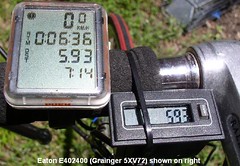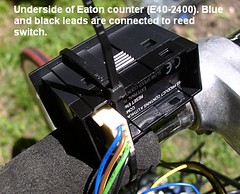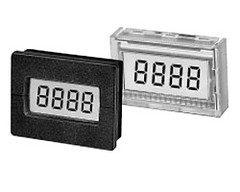Neville Wood
6-22-07
1. Introduction
I was very interested to read about Steve Collins novel electronic version of the Jones counter using a commercial electronic counter (Omron H7EC-NV-B, McMaster 1737T23, $54.59) coupled to a proximity detector. It did not seem competitive with my Protégé method, but I was excited to see that the counter module itself was only moderately priced and had several obvious advantages such as an always-on display with a battery life of 7 years. Steve had abandoned his research, and so kindly sent me his parts for my evaluation.
2. The Proximity Detector
The detector requires the use of a 9-volt battery and evidently requires a heavy current draw, because the one Steve sent was completely flat. After replacing the battery, the detector worked well with only one washer on the rim as a whole revolution counter. However, even with this improvement it did not appear competitive with the standard magnetic reed switch because of expense and other reasons.
3. The Omron Counter Coupled with a Reed Switch
I coupled the counter Steve sent with a reed switch from the Protege and it worked perfectly. Of course as for the Protege the counter was precisely synchronized with a calibrated rim. Steve had chosen this Omron with a voltage-only input because he was working with the proximity detector, and so I had to use the 9-volt battery also. However there is a version of this counter (McMaster 1737T22, $52.53) and many others that require only input from a switch closure.
4. The Eaton (Durant) E402400 Coupled with a Reed Switch


The Eaton counter can work with switch closure only and has an always-on display with a battery life of 10 years. I found one at my local Grainger warehouse for $44.75. I connected the low speed count input to the Protégé reed switch and it worked perfectly up to a bicycle speed of 15 mph or 3 rev/sec. However, the counter quit at higher speeds, and this was very strange since it is rated for up to 50 rev/sec. When I tried the high speed count input though, it worked fine. This input does not have de-bounce circuitry, but this does not matter at bicycle speeds.
5. Disadvantages of Commercial Electronic Counters Compared with Cyclocomputers
1. Cost
2. Weatherproofing: The Eaton front panel is waterproof, but the rest of the case must be sealed with the gasket and clips provided. Some are designed only for circuit boards.
3. Does not have other data outputs for other bicycling use.
4. Does not have a second counter like the Protégé 8 or 9.
5. Reed switch and magnet have to be obtained separately.
6. Advantages of Commercial Electronic Counters Compared with Cyclocomputers
1. No programming required: I initially thought that programming the Protégé was a trivial matter especially as I have simplified the instructions. After talking with many measurers though, I find that they find it very challenging. It is quite an advantage therefore that the commercial counters come ready to count revolutions. The only button to operate is the reset.
2. Operation Standardized: Reset is always done just ahead of the start line and intuitively obvious. There is no need to memorize the special quirks of each individual counter.
3. Reset instantaneous as opposed to taking a couple of seconds.
4. Decrement Mode: A much-touted unique advantage of the Jones is that it can be reversed to correct for a missed mark by backing up the bicycle. However, some commercial counters can operate in decrement as well as increment mode, and so can do something similar. Backing up though is a clumsy and inaccurate procedure. The commercial counters have the advantage over the Jones though in that they also allow the bicycle to be turned around and ridden back while decrementing the reading.
5. Always-on Display: The counters do not fall asleep after 5 min of inactivity and the measurer does not have remember to awaken them before resuming measurement.
6. Display for Revolutions only and Uncluttered by Irrelevant Data.
7. Battery Life: This is usually from 7 to 10 years and can be as long as 20 years!
8. Ruggedness: Since they are of industrial grade, I anticipate that they may be more long lasting.
9. Indefinite Availability: The counters are used in commercial operations and therefore will always be available in contrast to recent experience with cyclocomputers and the Jones.
7. Future Evaluations
I have ordered four different models of Veeder-Root counters for evaluation. The 799984-322 shown below costs only $12.

8. Conclusions
With the simplicity of operation of the commercial electronic counters there seems little reason to prefer use of the Jones or to resurrect it.
If you would like me to send you one of these new easy-to-operate counters, please contact me though 919-846-6374 or NFWOOD AT HOTMAIL. Total cost with the sensor and postage will be between $30 and $70 depending on the meter selected.
